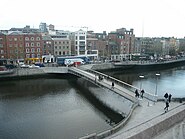Italian Quarter, Dublin
The Italian Quarter
An Ceathrú Iodálach City | Dublin | |
|---|---|---|
| Postal district | D01 | |
The Italian Quarter (Irish: An Ceathrú Iodálach) is an unofficially-named private development on the north bank of the River Liffey in central Dublin, Ireland.[a][3][b] The development comprises Bloom Lane, a pedestrianised alley, and the properties located along both sides of it, including an apartment complex known as Quartiere Bloom.[5][6] In 2019, Italy Magazine named the area as one of the places to find "one of the more convincing approximations of mangiare all'italiana" in Dublin.[3]
With "European-style" dining establishments and cafes, the Italian Quarter is one of several mixed-use quarters that have appeared in Dublin since the 1990s, promoted by the Dublin City Council and private developers.[7]
Background
Originally developed by MEP Mick Wallace as part of an urban regeneration project on what was considered the 'decaying northern quays', the 'Italian Quarter' opened in 2004.[8][9] His former building company M&J Wallace was the main developer.[10] Designed by architect George Morris, the development retained the facade of an older building on the quays.[11] The frontage was cut through to create a pedestrian access route extending from the Millennium Bridge through the Italian Quarter to a zebra crossing, leading to the rest of the Millennium Walkway and the Jervis stop on the Luas Red Line.[11][6]
Wallace, an Italophile who once owned property in Turin and a vineyard in Piedmont, declared bankruptcy in 2016.[10] In February 2023, the Irish Independent reported that the holding company Wallace Calcio, which he exited but continued to advise, was associated with 10 businesses including wine bars, restaurants, and cafes near the Italian Quarter.[12]
Italian eateries in the quarter include Caffe Cagliostro, located alongside the iconic photo mural Dublin's Last Supper;[3] Wallace's Taverna, a restaurant and pizzeria that first opened in 2005;[13] Sfuso, formerly known as Enoteca Delle Langhe, a gastronomia or deli and wine bar serving aperitivo;[4] and Bar Italia, whose pasta dishes often appear on social media.[14] Despite the name, the Italian Quarter is also home to a Thai restaurant,[15] a burrito shop,[16] and other establishments, including a hookah bar.[11]
Dublin's Last Supper
A large-scale photographic artwork by Irish artist John Byrne entitled Dublin's Last Supper was installed in 2004 covering the side of a wall within the courtyard in the Italian Quarter. Depicting a modern-day re-enactment of Leonardo da Vinci's The Last Supper, Byrne added an 'Irish twist' by replacing the Biblical characters with a cast of local Dubliners that reflected the "changing society and the growing cultural mix in Dublin" at the time.[17]
Although it stirred some controversy when it was first unveiled, over the years, Dublin's Last Supper has become one of the more popular public artworks located across Dublin.[18]
Gallery
-
Looking northwards across the Millennium Bridge towards the Italian Quarter
-
View of Italian Quarter from Millennium Bridge (2006)
-
Wallace's Taverna on the corner of Ormond Quay Lower and Bloom Lane (2016)
-
Dublin's Last Supper as seen in 2021
Notes
- ^ Not to be confused with Dublin's historic 'Little Italy', which in the late 1800s and early 1900s was located in the area around Chancery Lane, Little Ship Street, and Werburgh Street.[2]
- eircodeaddresses for premises located along Bloom Lane:
STUSO
3 Bloom Lane
Ormond Quay Lower
Dublin 1
D01 V127It is however sometimes quoted in newspapers when referring to the addresses of restaurants along the lane.[4] As of August 2023, the name 'The Italian Quarter' is also unrecognised by Ireland's placenames database.
References
- ^ "Sagart na Paróiste". www3.smo.uhi.ac.uk.
- .
- ^ a b c Appleton, James (8 December 2019). "Where to Find Italy in Dublin". Italy Magazine. Retrieved 8 August 2023.
- ^ a b Hardgrave, Corinna (17 October 2020). "Eat like an Italian on a cosy covered al-fresco terrace". The Irish Times. Retrieved 28 August 2023.
- .
- ^ a b "City centre living with views of the 'Dublin's Last Supper' mural for €400k". Irish Independent. 26 November 2021. Retrieved 28 August 2023.
When city districts are fabricated, rather than developing organically, there can often be confusion about what they're called. Take Dublin's so-called Italian Quarter, which was formerly described as Quartiere Bloom and yet is also part of the much-hyped Millennium Walkway dreamt up by property developers and the city council.
- S2CID 53422471– via EBSCOHost.
- ^ McDonagh, Darragh (25 June 2019). "Wallace-owned bars saw profit rise by 84% last year". The Irish Times. Retrieved 8 August 2023.
- thejournal.ie. Retrieved 8 August 2023.
- ^ .
- ^ a b c O'Toole, Shane; McDonald, Frank (3 March 2018). "Dublin's north quays: Then and now in photographs". The Irish Times. Retrieved 28 August 2023.
- .
- ^ "Wallace's Taverna". Wallace's Italian Winebars. Retrieved 28 August 2023.
- .
- ^ Turner, Sara (27 April 2009). "Surviving the world's most expensive cities: Dublin". Business Traveller. Retrieved 28 August 2023.
You may not think of visiting Dublin's Italian quarter for Thai food, but you can't go far wrong with Koh.
- ^ O'Connor, Chris (22 January 2013). "The Burrito Wars". University Times. Retrieved 28 August 2023.
- ^ "Dublin's Last Supper". publicart.ie. Retrieved 8 August 2023.
- ISBN 978-3-95451-649-0.




